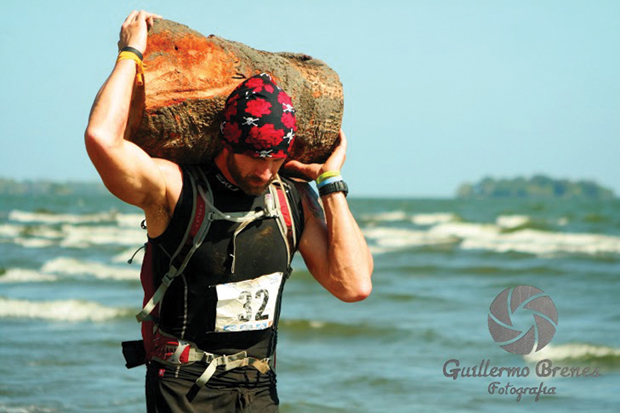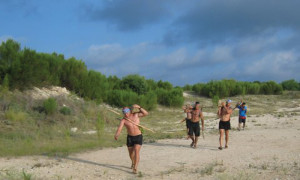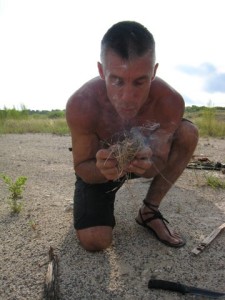Controlled Chaos: Surviving an Extreme Event

Extreme endurance races offer the chance for racers to experience an adventure, but danger is inherent to any real adventure. Extreme endurance races are growing in participation every year, but many people are concerned about the safety of such events. In the 2013 inaugural Fuego y Agua: Survival Run this past February, 40 elite athletes were pushed into true survival mode in an extreme 80K (almost 50 miles) ultramarathon obstacle course on the volcanic island of Ometepe in Nicaragua. Participants climbed 30-foot tall coconut trees, swam against waves for more than a mile along a shoreline of jagged rocks, ascended and descended steep volcanoes through dense jungle terrain, and carried livestock, among a dozen other trials. Racers faced very real dangers during their 20-hour race, yet all came out alive and well (with the exception of some minor sprains, cuts, and bruises). How does a race director manage to make an extreme event challenging while still keeping athletes safe?
 The delicate balance between minimizing unnecessary risks and offering a true challenge is something that every extreme endurance race director has to deal with. Three of the most effective tactics for maintaining this balance are intelligent, informed planning; assuring that participants are personally prepared; and having the experience and knowledge needed to make smart choices. Race directors, who take into consideration location, terrain conditions, distance, and the particular obstacles on the course, play an active role in minimizing risk in an informed and intelligent manner. Here are a few examples of several extreme events and the varied ways that safety for competitors is promoted.
The delicate balance between minimizing unnecessary risks and offering a true challenge is something that every extreme endurance race director has to deal with. Three of the most effective tactics for maintaining this balance are intelligent, informed planning; assuring that participants are personally prepared; and having the experience and knowledge needed to make smart choices. Race directors, who take into consideration location, terrain conditions, distance, and the particular obstacles on the course, play an active role in minimizing risk in an informed and intelligent manner. Here are a few examples of several extreme events and the varied ways that safety for competitors is promoted.
For the Fuego y Agua Survival Run and Ultras in Nicaragua, race director Josue Stephens teamed up with the one hospital in the country capable of treating potential event emergencies, such as heat stroke, dehydration, muscle fatigue, and serious traumas. Doctors and nurses from the hospital are sent to the island and strategically placed on standby in various locations along the race’s 80K route in case of emergency. In addition, local, experienced volcano guides are stationed along the more dangerous sections of the jungle trail to direct and assist runners as needed. A helicopter is placed at the ready and volunteers, medical staff, guides, coordinators, and race directors are all connected via phones and radios.
At the Ultramarathon Caballo Blanco (UMCB)—made famous as the Copper Canyon Ultramarathon in Christopher McDougall’s national bestseller Born to Run—racers from all over the world congregate in the small town of Urique, Mexico (eight hours from the closest big city) to run 50 miles of desert trails. To ensure the safety of the runners and the volunteers of the UMCB as they make their way through the Copper Canyons, race directors work directly with local government officials and local law enforcement to make sure that both the host town and the course are secure and all the runners are safe. Due to months of advance planning, coordination with local authorities, well-stocked aid stations, onsite medical personnel, and a plethora of experienced volunteers, the 700 participants of the 2013 UMCB enjoyed a challenging but wonderful race with no serious injuries.
Brad Quinn, founder and co-director of the popular Capt’n Karl’s Night Time Trail Series, prepares an emergency action plan (EAP) for all of his races. The Capt’n Karl’s races are a series of nighttime trail races consisting of extremely technical courses throughout the Texas Hill Country. Given the combined challenges of night running and treacherous trails, extra safety precautions must be taken.
Quinn’s EAP document includes directions to the nearest hospital and the contact information for the local emergency medical services (EMS), and EMS is contacted well before every event so that responders are aware of the race and the types of potential emergencies they may encounter. Often, EMS will arrive with an ambulance as a precautionary measure and provide on-scene support for free or a minimal cost.
In the eight years that the Capt’n Karl races have been held, the most serious incident occurred recently when a runner fell and broke a wrist; a splint was applied and the individual was transported to and treated at the nearest hospital. It is not by coincidence or through luck that the nighttime trail race series, consisting of some of the toughest courses in Texas, has seen no major injury in its history; it is because the race directors have taken precautionary measures to ensure runners are advised of particular dangers on the course. Some other advance measures include staffing aid stations with experienced volunteers who know how to recognize a runner in danger of dehydration or heat exhaustion and having emergency personnel on site or on alert.

Assuring that the racers are prepared to face the rigors of the event is another way to minimize risk of serious injury. While it is generally understood that race directors are not responsible for ensuring that participants are fully trained and prepared, many companies do what they can to assist runners in their training efforts; for example, both the Spartan and Tough Mudder events produce and post training videos to help their participants prepare. Recently, Fuego y Agua hosted a training camp so that competitors in this year’s Survival Run: Hunter Gatherer could learn how to make a fire with a bow drill, craft their own bow and arrows, hunt small game with a throwing stick, and even fashion a container and water filter out of a cactus—all of which are skills involved in that event.
In addition to the training camp, participation in the Fuego y Agua Survival Run and Ultras requires an application so that only capable competitors register. Applicants have included top-three finishers in extreme endurance events and obstacle courses; severalwith military backgrounds; and one participant who included a story about fighting off a live shark. At this year’s Fuego y Agua races, competitors swam 800 meters to a boat in order to pick up their race packets—and in the course, prove their swimming skills. Those unable to make the swim were disqualified because the swimming obstacles in the race are far more challenging.
Extreme endurance racers recognize that, ultimately, being well trained and prepared to face any obstacle is their own responsibility. John Taylor of VPX Team Xtreme explained his tactics: “Prep wise, I try to train in many different conditions: rested, tired, sick, mad, happy, dark, heat, rain, cold, hungry, after a meal, etc. Basically, if I can become comfortable in misery I feel you are better suited on race day. Anyone can perform in ideal conditions.” Isaiah Vidal, an elite obstacle course racer from Marble Falls, agreed. “You don’t just go do a marathon or triathlon without properly training for it,” Vidal said. “You train by learning proper techniques on how to swim, bike, and run all in one day. The same works with obstacle course racing… Prepare yourself to endure and conquer by studying the different strengths you need…Learn how to tackle a specific event, whether you are competing or just trying to finish. Learn and do your research or pay for it on race day.”
The race directors’ ability to quickly make smart decisions can also be a determining factor in participant safety. Many can share stories of times when some unforeseeable problem arose during a race and they had to think fast to come up with a decision. Quinn recalled the year that the Capt’n Karl’s Inks Lake race was nearly cancelled due to a 500-year flood. Three days before the start, the surrounding area received over 18 inches of rain in a matter of hours. Businesses closed, homes were destroyed, and the National Guard was called in; it looked like race conditions would be quite dangerous. Fortunately, Quinn was able to mark some last minute changes to the course that kept runners from the most affected parts of the park. Thanks to these course changes and other last minute decisions, all the runners had a safe and fun—albeit muddy—experience.
Experienced and knowledgeable volunteers and crew are also essential to the safety of a race. A volunteer working at an aid station at a nighttime race at Reveille Peak Race had to make the decision to pull a runner: “A runner came into my aid station and was showing classic signs of dehydration. The runner was also not speaking coherently and seemed to be fainting on her feet. I felt bad about ending her run that night, but I knew that pulling her from the race and calling for medical help was the right decision. I was really happy to see her at the next race–she was looking a lot better and a lot more prepared.”
The racers themselves have the most power to protect themselves from unnecessary risks during an event. Obstacle racer John Taylor explained, “The way I see it, race organizers and staff trying to ensure the safety of elite endurance/obstacle racers is like child trying to walk a tiger on a leash; we are ‘controlled chaos’ by nature, and the only guarantee of safety [are] the choices we make during a race.”
Sometimes experience and knowledge leads a racer to make a tough call. This July at the world famous 135-mile Badwater ultramarathon in Death Valley, Lisa Smith Batchen made the heart wrenching decision to drop out. She had been training for the better part of a year, but sudden acute sciatic pain made it impossible for her to continue beyond mile 113. Dropping was an especially difficult decision for Lisa because she was running to raise funds for clean water wells through her Badwater 4 Good Water organization. Batchen felt she made the right call; she doesn’t refer to it as a DNF (did not finish) but sees her decision to stop as an MTRC (Made The Right Choice).
As the number of extreme endurance events grows, it becomes increasingly important for all involved to focus on intelligent and informed planning, personal preparation, and for participants to their experience and knowledge to make smart decisions.
Zac Wessler is an event coordinator for Fuego y Agua Events LLC and an avid runner. He currently resides in Austin, Texas.
Amanda Esquivel is a trail running enthusiast and long time resident of the Austin area. She runs so that if she ever meets the last of the Time Lords, she’ll be ready.






